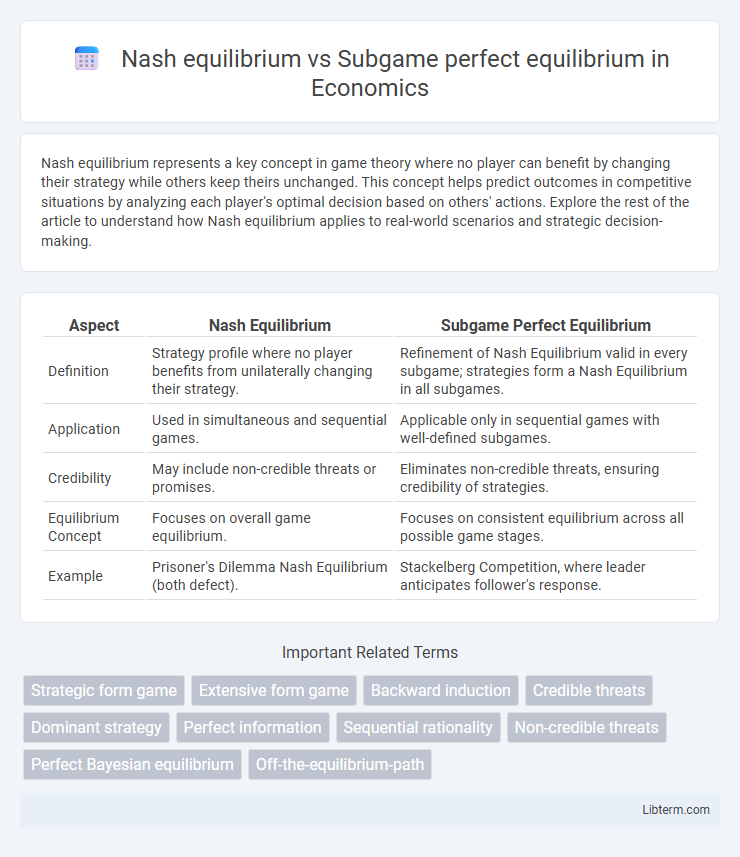Nash equilibrium represents a key concept in game theory where no player can benefit by changing their strategy while others keep theirs unchanged. This concept helps predict outcomes in competitive situations by analyzing each player's optimal decision based on others' actions. Explore the rest of the article to understand how Nash equilibrium applies to real-world scenarios and strategic decision-making.
Table of Comparison
| Aspect | Nash Equilibrium | Subgame Perfect Equilibrium |
|---|---|---|
| Definition | Strategy profile where no player benefits from unilaterally changing their strategy. | Refinement of Nash Equilibrium valid in every subgame; strategies form a Nash Equilibrium in all subgames. |
| Application | Used in simultaneous and sequential games. | Applicable only in sequential games with well-defined subgames. |
| Credibility | May include non-credible threats or promises. | Eliminates non-credible threats, ensuring credibility of strategies. |
| Equilibrium Concept | Focuses on overall game equilibrium. | Focuses on consistent equilibrium across all possible game stages. |
| Example | Prisoner's Dilemma Nash Equilibrium (both defect). | Stackelberg Competition, where leader anticipates follower's response. |
Introduction to Game Theory Concepts
Nash equilibrium represents a strategy profile where no player can benefit by unilaterally changing their strategy, ensuring mutual best responses in a static game setting. Subgame perfect equilibrium refines this concept by requiring strategies to constitute a Nash equilibrium in every subgame, effectively eliminating non-credible threats in dynamic games with sequential moves. These foundational game theory concepts enable rigorous analysis of strategic interactions and predict stable outcomes in both simultaneous and sequential decision-making scenarios.
Defining Nash Equilibrium
Nash Equilibrium occurs when no player can improve their payoff by unilaterally changing their strategy, assuming other players' strategies remain fixed. This concept applies to simultaneous-move games where every player's strategy is optimal given the strategies of others. In contrast, Subgame Perfect Equilibrium refines Nash Equilibrium by requiring strategy profiles to constitute a Nash Equilibrium in every subgame, ensuring sequential rationality.
Understanding Subgame Perfect Equilibrium
Subgame Perfect Equilibrium (SPE) refines Nash Equilibrium by requiring strategy profiles to constitute a Nash Equilibrium in every subgame of the original game, ensuring credibility and consistency in dynamic settings. Unlike Nash Equilibrium, which may allow non-credible threats or promises, SPE eliminates such inconsistencies by applying backward induction to analyze sequential rationality. SPE is critical in extensive-form games where players make decisions at various stages, providing a more precise prediction of strategic behavior over time.
Key Differences Between Nash and Subgame Perfect Equilibria
Nash equilibrium represents a strategy profile where no player can benefit by unilaterally changing their strategy, applicable to whole games without considering sequential moves. Subgame perfect equilibrium refines Nash equilibrium by requiring strategies to form a Nash equilibrium within every subgame, ensuring credibility and consistency at every stage of dynamic games. The key difference lies in subgame perfect equilibrium eliminating non-credible threats through backward induction, making it relevant for extensive-form games with sequential decisions.
Real-World Examples: Nash vs Subgame Perfect Equilibrium
Airline pricing strategies often illustrate Nash equilibrium, where competing airlines simultaneously set ticket prices without unilateral incentive to deviate, maintaining stable market shares. In contrast, subgame perfect equilibrium is evident in sequential bargaining scenarios like negotiations between suppliers and retailers, where each party anticipates future moves and optimizes accordingly at every stage. These real-world applications highlight how Nash equilibrium captures static strategic interactions while subgame perfect equilibrium models dynamic decision-making with credible threats and promises.
The Role of Credibility in Strategic Decisions
Nash equilibrium represents a strategy profile where no player benefits from unilaterally changing their strategy, but it may include non-credible threats or promises that players would not follow through on in actual play. Subgame perfect equilibrium refines Nash equilibrium by requiring strategies to constitute a Nash equilibrium in every subgame, ensuring all threats and promises are credible and consistent with rational behavior at every stage. The role of credibility in strategic decisions is crucial, as subgame perfect equilibrium eliminates non-credible strategies, leading to more reliable predictions in sequential games.
Extensive Form Games and Their Equilibria
In extensive form games, the Nash equilibrium represents a strategy profile where no player can improve their payoff by unilaterally deviating, but it may include non-credible threats off the equilibrium path. Subgame perfect equilibrium refines this by requiring strategies to constitute a Nash equilibrium in every subgame, ensuring credibility and consistency of threats throughout the game tree. This refinement eliminates non-credible equilibria in sequential games, providing a more accurate prediction of player behavior in dynamic settings.
Applications in Economics and Business
Nash equilibrium models strategic decision-making where each player's strategy is optimal given others' choices, commonly used in market competition and auction design to predict stable outcomes. Subgame perfect equilibrium refines this by requiring strategy credibility in every subgame, crucial for analyzing sequential moves in bargaining, contract theory, and dynamic pricing strategies. These concepts guide firms in anticipating rivals' behaviors, optimizing pricing, and designing incentive-compatible contracts to sustain long-term profitability and market stability.
Common Misconceptions and Pitfalls
Nash equilibrium and Subgame perfect equilibrium are often confused, yet the former considers strategy profiles stable only in the entire game, while the latter refines this concept by requiring credible strategies in every subgame. A common misconception is that every Nash equilibrium is subgame perfect, ignoring that some Nash equilibria rely on non-credible threats or promises that fall apart when examined subgame by subgame. Failing to distinguish between these leads to pitfalls in predicting realistic strategic behavior, especially in dynamic games with sequential moves.
Conclusion: Choosing the Right Equilibrium Concept
Selecting the appropriate equilibrium concept depends on the strategic context and the complexity of the game. Nash equilibrium provides a broad solution framework for simultaneous-move games, while subgame perfect equilibrium refines predictions by ensuring credibility and consistency in dynamic, sequential interactions. For extensive-form games with multiple stages, subgame perfect equilibrium offers more precise strategic insights by eliminating non-credible threats and ensuring optimal decisions in every subgame.
Nash equilibrium Infographic

 libterm.com
libterm.com